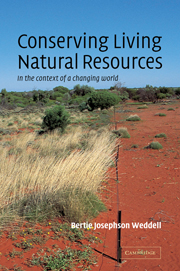Book contents
- Frontmatter
- Contents
- Preface
- Introduction: Balance and flux
- Methodology: Getting the information we need to manage living natural resources
- Part I Management to maximize production of featured species – a utilitarian approach to conservation
- Part II Protection and restoration of populations and habitats – a preservationist approach to conservation
- 7 Historical context – the rise of environmental concerns after World War II
- 8 Central concepts – the causes of extinction
- 9 Techniques – protecting and restoring species
- 10 Techniques – protecting and restoring ecosystems
- Part III Management to maintain processes and structures – a sustainable-ecosystem approach to conservation
- Postscript
- Appendix: Scientific names of organisms mentioned in the text
- Index
7 - Historical context – the rise of environmental concerns after World War II
Published online by Cambridge University Press: 05 June 2012
- Frontmatter
- Contents
- Preface
- Introduction: Balance and flux
- Methodology: Getting the information we need to manage living natural resources
- Part I Management to maximize production of featured species – a utilitarian approach to conservation
- Part II Protection and restoration of populations and habitats – a preservationist approach to conservation
- 7 Historical context – the rise of environmental concerns after World War II
- 8 Central concepts – the causes of extinction
- 9 Techniques – protecting and restoring species
- 10 Techniques – protecting and restoring ecosystems
- Part III Management to maintain processes and structures – a sustainable-ecosystem approach to conservation
- Postscript
- Appendix: Scientific names of organisms mentioned in the text
- Index
Summary
In Part I we saw how management of living natural resources developed in response to unregulated exploitation and how the disciplines of utilitarian forestry, wildlife management, and range management emphasize regulated exploitation of selected species. This kind of management was a great improvement over unregulated exploitation and sometimes succeeded in sustaining the take of harvested species, in controlling unwanted organisms, and in manipulating habitats for the benefit of certain organisms, but it has not been entirely satisfactory. Utilitarian management simplifies managed habitats and sometimes fails to foresee some of the consequences of this simplicity. Furthermore, changing conditions in the middle of the twentieth century created new pressures on species and habitats, and changing values dictated a broader focus, one that considered the needs of all species. This chapter describes the evolution of an approach to resource management that seeks to preserve living things regardless of their utilitarian values.
The roots of this approach go back to a nineteenth-century movement to preserve wild places for their intrinsic beauty and spiritual value (see the Introduction). A century later, awareness of environmental problems and the accelerating loss of species provided additional motivation for preserving wild things from human impacts.
This chapter examines the rise of environmental concerns about several interrelated problems: introduced organisms, toxins in the environment, impacts of human resource use, and the loss of species. It does not contain an exhaustive review of environmental problems.
- Type
- Chapter
- Information
- Conserving Living Natural ResourcesIn the Context of a Changing World, pp. 163 - 193Publisher: Cambridge University PressPrint publication year: 2002



